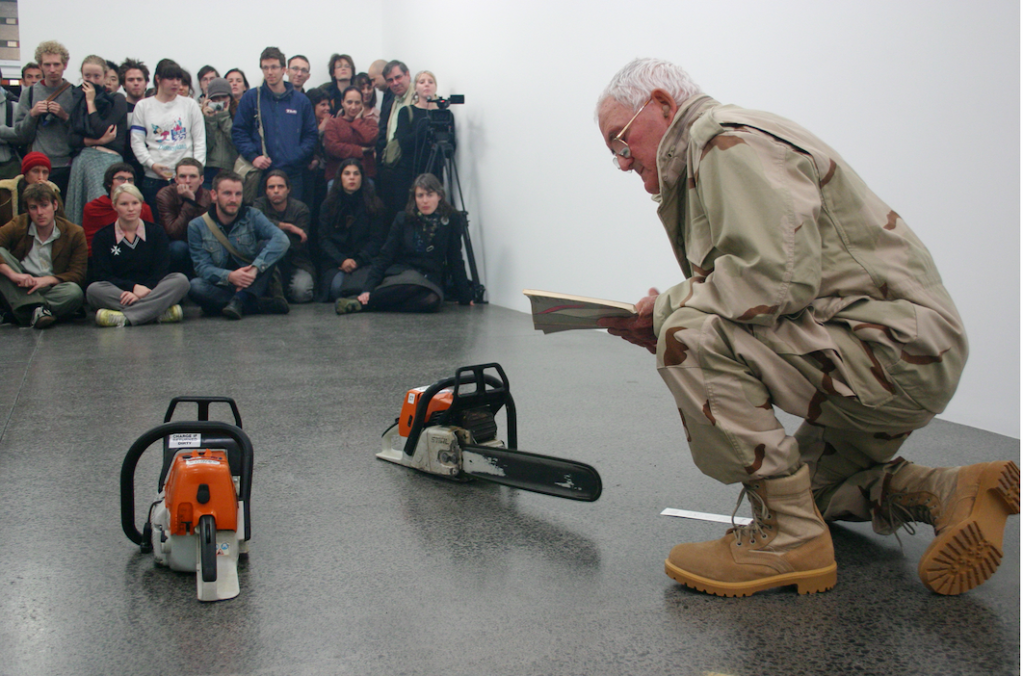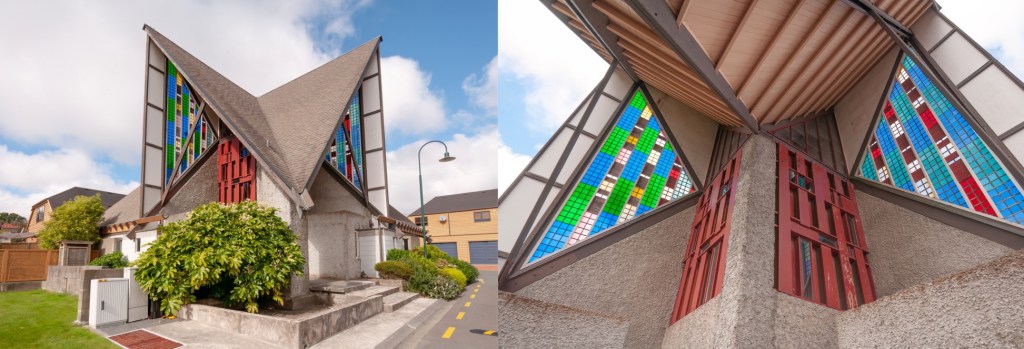Aotearoa's Father Of Experimental Art - Tributes Flow After Passing of Jim Allen
Performance artist, provocateur and educator - the creative world reacts to the loss of creative icon Jim Allen, and a look at the indelible impact he made in his 100 years.

Last year, Aotearoa artist Jim Allen MNZM turned 100. It was a moment to celebrate his career and legacy as one of New Zealand’s most dynamic and influential proponents of experimental art. We are now at another moment to pause and salute Allen, who died last Friday (9 June).
Many on both sides of the ditch will remember Allen. He was not only a formative artist, but also leaves an incredible legacy as an arts educator, both in New Zealand and Australia.
"[He] lives on in the generations of artists who have taken inspiration from his relentless sculptural innovations and dedication to the teaching and learning of artistic practice", said Allen’s gallerist Michael Lett this week.
His daughter, Melbourne-based glass artist, Ruth Allen posted a tribute to her father on Instagram:
The sector remembers Allen
Tributes have rolled out across social media. The Arts Foundation Te Tumu Toi, which named Allen an Arts Foundation Icon Whakamana Hiranga in 2015 (an honour awarded to only 20 people), wrote, "His impact – not only as an artist, but as one of the most influential arts educators of his generation – was monumental."
This sentiment was echoed by Auckland Art Gallery Toi o Tāmaki, which for his centenary last year celebrated the artist with the exhibition Jim Allen: 100 years: "His life story is broad and legendary, and his legacy for arts in the city is profound. Allen had a long-lasting influence on the establishment of the contemporary art scene in Auckland, aligning it with the dynamic changes occurring globally."
Lett added on Instagram that Allen was "ever selfless and politically engaged".
art news nz called Allen, "a pivotal figure in Aotearoa’s conceptual and performance art canon", while Rhana Devenport, Director of Art Gallery of South Australia and former Director of Govett-Brewster Art Gallery in Taranaki/New Plymouth - where she showed a number of Allen’s early CONTACT works - described him as an "inspirational and radical conceptualist and teacher".
We need radical thinkers and makers to push the boundaries forward. This is what Allen did so well, within the embrace of an education environment.
Jim Allen, the teacher
Allen was an original and innovative thinker, which placed him well to shepherd a next generation of artists with a passion for post-object art and performance art. He taught across institutions in Auckland, Adelaide and Sydney.
While he was the inaugural Head of the School of Art at the University of Sydney between 1977 and 1987, his love of teaching started much earlier. After graduating from London’s Royal College of Art in 1952, he took up a role as a field officer for the Northern Māori Project (1953-59), an initiative of New Zealand Department of Education under Gordon Tovey.
He then joined the staff of the Elam School of Fine Arts (University of Auckland) and became Head of Sculpture (1960-1976). Critic and writer Wystan Curnow praised Allen’s work at the school, as "making the institution a hothouse, which brought contemporary art in New Zealand up to speed internationally".

Jim Allen, ‘Poetry for Chainsaws’, 1976, performance, Michael Lett, Auckland, 2006. Image: Courtesy of Michael Lett, Auckland, New Zealand.
Jim Allen, the artist
As the 1960s progressed, Allen increasingly shifted his focus to his own practice. He took a sabbatical year off from teaching in 1968 to travel, which kick-started his passion for conceptual performances. He often turned to unorthodox materials, such as plastic sheeting, barbed wire and, famously, chainsaws. He also used a lot of text and immersive qualities – including smell – in his installations.
In Stuff, Te Papa Museum chief executive Courtney Johnston says that Allen had an enormous influence on how art was experienced by audiences. "The idea of immersive art experiences is widespread now, but it had to be invented … and Jim Allen was one of our most important art inventors."
While these milestone moments were ephemeral, many have been restaged and re-documented over the past two decades, to continue their legacy for a next generation, and also to be collected.
For Allen’s 100th celebrations last year, his daughter Ruth Allen performed his seminal work Poetry for Chainsaws (1976), which comprises a recitation of Allen Ginsberg’s poem Howl (1956) against the roar of chainsaws, until they run out of fuel.
Allen’s key experiential sculptures were Small Worlds (1969), Tribute to Hone Tuwhare (1969), Arena (1970), Contact (1974) and the two-part installation O-AR (1974) and O-AR 1 (1975).
His celebrated performances include Computer Dance (1974), News (1976) and On Planting a Native (1976) – a number of which were performed at the Experimental Art Foundation in Adelaide (now Adelaide Contemporary Experimental). His video works have been shown in the US, Germany and the Netherlands.

Futuna Chapel in Wellington. Image: Shutterstock.
Jim Allen, in the public realm
A few years after his travel abroad, Allen was involved in a milestone project that would bring him to the attention of many New Zealanders, when he collaborated with architect John Scott on Futuna Chapel in Wellington.
Also in Stuff Gregory O’Brien wrote that the "building became, inadvertently, a profound interaction between an architect and a visual artist".
"Controversial when the chapel was opened in 1961, Allen’s Stations of the Cross and crucifix brought the story of Christ’s Passion into a genuinely international, postcolonial focus."
The project encompassed Allen’s deep interest in combining South Pacific nuances and the European modernist tradition. Auckland Art Gallery Toi o Tamaki curator, the late Ron Brownson called Allen’s 2.5-metre (8.2 feet) high "pan-cultural Christ one of the most significant wood carvings produced in New Zealand during that period". The statue was stolen around 1999, recovered in 2012 and subsequently restored and conserved.
This wasn’t Allen’s first foray into the public domain. In 1959, he designed the stained glass windows for Scott’s Our Lady of Lourdes Church, Havelock North, and in 1962 elements for John’s Church in Te Awamutu. He also made a seven-metre (23 feet) long sculptured concrete panel, as a commissioned piece for the Wellington offices of chemical company ICI (1965). The panel survived the 2016 earthquake.
Other public artworks include Wairaka (1965), a kinetic water sculpture in Whakatāne; Conversation piece (1967), a public sculpture in the Auckland suburb of Pakuranga; a stainless steel sculpture for Expo ’70 Osaka (1970); and the Commonwealth Games sculpture, Christchurch (1974) for Queen Elizabeth II Park.
Jim Allen, the man
Born William Robert ‘Jim’ Allen in Wellington in 1922, he first studied drawing and sculpture at Wellington Tech. While the war took Allen to North Africa and Italy, it also meant he was placed to continue his studies of art at Perugia University and at the Istituto d’Arte Florence in Italy.
He received a Diploma of Fine Arts from Canterbury University College (Christchurch), before returning to London to undertake a degree in sculpture at London’s Royal College of Art – where he immersed himself in the modernist avant-garde – graduating in 1952. Allen returned to New Zealand, and committed himself to art education.
After further travels, in 1998 he returned again to New Zealand, making Auckland his home.
In 2000, Allen was made Fellow, Australian Council of University Art and Design Schools. Then in 2004, he was appointed a Member of the New Zealand Order of Merit for services to education and the arts. That was followed in 2007 with Honorary Doctorates from Auckland University of Technology and the University of Sydney. Then, in 2015, Allen was named an Arts Foundation Icon Whakamana Hiranga by the Arts Foundation of New Zealand.
In 2021 Allen gifted three significant works to the Auckland Art Gallery Toi o Tāmaki Collection, building on its holding of his early formative sculptural pieces and radical performance works.
Allen had been represented by Michael Lett Gallery since 2006. He is survived by his wife, children’s author Pamela Allen MNZM, and two children.
This article was originally published by our friends at ArtsHub Australia.
Written by Gina Fairley.